Do you want bigger, stronger biceps? If so, you need to do the right exercises. There are many different biceps curl variations out there, but not all of them are created equal.
The standard bicep curl, hammer curl, and reverse curl each work the biceps brachii, brachialis, and forearm muscles differently, resulting in varied outcomes.
In my journey to build arm size, I’ve found that the key to impressive biceps isn’t just how much you lift, but how you lift and what exercises you do.
Let’s compare three of the most popular bicep curl variations: the standard bicep curl, the hammer curl, and the reverse curl.
And discuss which muscles worked, the unique benefits of each exercise, and how to perform them. By the end, you will know which curl best suits your goals.
Know More: 12 Best Ways To Do Bicep Curl (Dumbbell, Barbell & Cable)
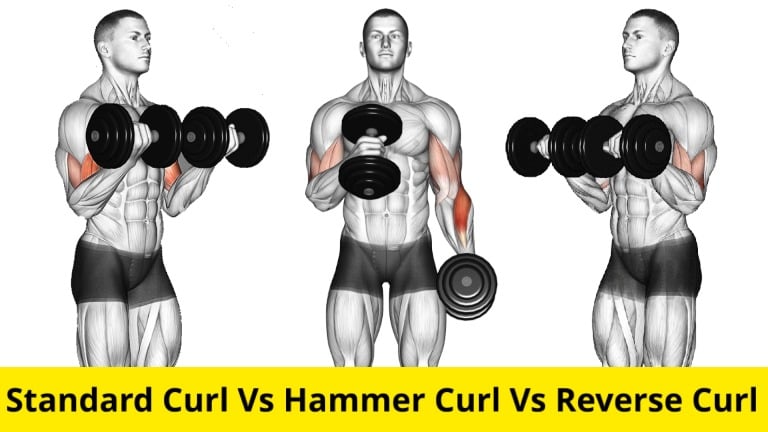
- Standard Bicep Curl vs Hammer Curl vs Reverse Curl
- 1. Standard Bicep Curl
- Muscles Worked
- Benefits Regular Bicep Curl
- How To Do Dumbbell Bicep Curl
- 2. Hammer Curl
- Muscles Worked
- Benefits Of Hammer Curl
- How To Do Dumbbell Hammer Curl
- 3. Reverse Curl
- Muscles Worked
- Benefits Of Reverse Curl
- How To Do Dumbbell Reverse Curl
- Bicep Curl Vs Reverse Curl
- Are Hammer Curls or Bicep Curls Better?
- Reverse Curls Vs Hammer Curls: Which Exercise Is Better?
- FAQs
- Hammer Curl vs. Reverse Curl: When Should You Do Each?
- Should I do hammer curls or bicep curls first?
- Are reverse curls easier than regular curls?
- Do reverse curls build forearms?
- Conclusion
- References
Standard Bicep Curl vs Hammer Curl vs Reverse Curl
| Feature | Standard Bicep Curl | Hammer Curl | Reverse Curl |
|---|---|---|---|
| Grip | Palms facing upward (supinated grip) | Palms facing each other (neutral grip) | Palms facing downward (pronated grip) |
| Muscles Worked | Biceps brachii | Long head biceps and brachialis | Brachialis and brachioradialis (forearm muscle) |
| Benefits | Builds overall bicep size and strength, particularly the peak | Contributes to overall bicep development and forearm thickness | Improves forearm strength and size |
| Best For | Building overall muscle mass in the biceps | Making arms stronger and more balanced | Strengthening the brachioradialis (forearm muscles) |
Want to take your gains to the next level? Discover your daily calorie needs with our free TDEE calculator
1. Standard Bicep Curl
If you want to increase the size of your bicep, the standard curl is the best choice. It is a classic bicep-building exercise known for its simplicity and effectiveness. It involves lifting a weight (usually a dumbbell or a barbell) with an underhand grip.
Unlike its friends, the Hammer Curl and the Reverse Curl, the Standard Bicep Curl locks onto your biceps with laser precision.
There are different ways to do a standard bicep curl to build bigger and stronger biceps.
- Dumbbell Bicep Curl
- Cable Curl
- Wide Grip Barbell Curl
- Close Grip Barbell Curl
- Ez Bar Curl
Note: In the study conducted, they found that the EZ barbell curl showed the highest overall electromyography (EMG) activity in the biceps brachii (BB) and brachioradialis (BR) muscles compared to the dumbbell curl (DC) and barbell curl (BC) variants.
Muscles Worked
- The regular bicep curl primarily works the biceps brachii.
- Some other secondary muscles worked, including brachialis, brachioradialis, and forearm muscles.
- The bicep curl has the involvement of several synergist muscles, these muscles include, oblique and core muscles.
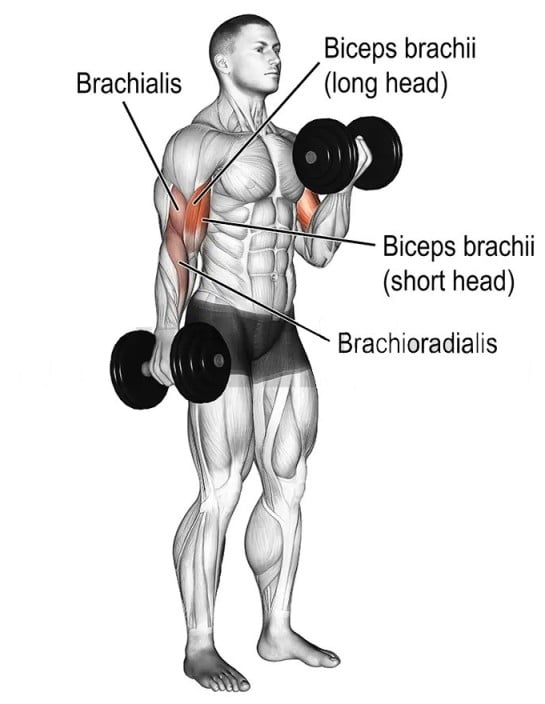
Benefits Regular Bicep Curl
- It allows you to lift heavier weights.
- Works all the heads of the biceps
- It is a relatively straightforward exercise to learn.
- Better mind-muscle connection.
- It can be performed with various gym equipment
- It is easier to overload progressively.
How To Do Dumbbell Bicep Curl

- Stand with your feet shoulder-width apart.
- Hold a dumbbell in each hand with a supinated grip (palms facing up).
- Exhale and slowly curl the dumbbells up towards your shoulders
- Continue to raise the dumbbells until your forearms are perpendicular to the ground.
- To pause briefly, squeeze your biceps at the top of the movement.
- Inhale as you slowly lower the dumbbells back to the starting position.
- Keep tension on the biceps throughout the entire range of motion.
- Aim for 3–4 sets of 8–12 repetitions for each set.
Know More: Barbell Bicep Exercises & Workout For Mass & Strength
2. Hammer Curl
It’s very similar to the biceps curl, with the only difference being the neutral (hammer) hand position. It is one of the best exercises that you can do to build your forearm and bicep muscles.
Hammer curls work the brachialis muscle, which is underneath the biceps and makes the upper arm thicker. They also work the brachioradialis muscle, which is important for grip strength and forearm size.
There are different ways to do a hammer curl:
- Seated Hammer Curl
- Cross-Body Hammer Curl
- Cable Hammer Curl
- Olympic bar Hammer Curl
Muscles Worked
- The hammer curl targets the upper and lower arm muscles — most notably the brachialis and brachioradialis.
- Secondary muscles worked: biceps Brachii,
- Stabilizer muscles worked, including your Obliques and Rectus abdominis.
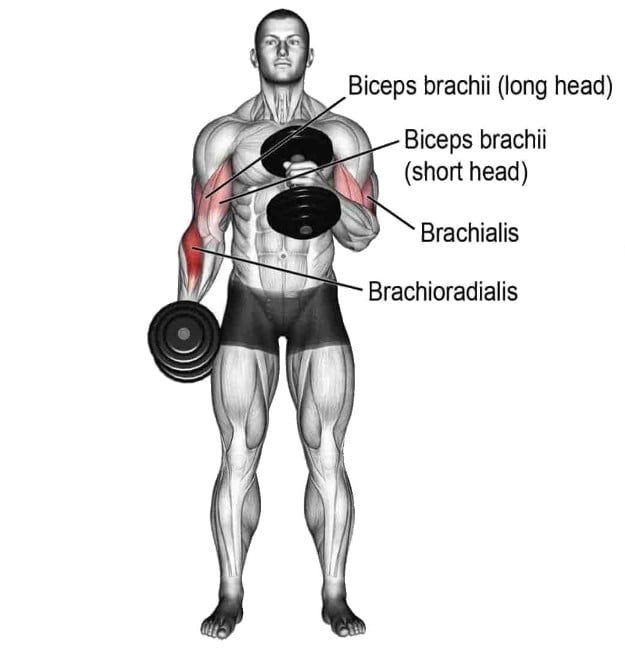
Benefits Of Hammer Curl
- Hammer curl Improved grip strength and overall forearm development.
- Works the biceps, forearms, brachialis, and brachioradialis
- Neutral grip may take pressure off the wrists and elbows
- Places the primary stress on the long (outer) head of the biceps.
- This will help you challenge your muscles and prevent workout plateaus.
- It allows for a greater range of motion compared to traditional bicep curls.
How To Do Dumbbell Hammer Curl

- Stand with feet shoulder-width apart, knees slightly bent. Keep your core engaged and spine neutral.
- Hold a dumbbell in each hand with a neutral grip (palms facing each other). Hands should be hanging down by your sides.
- Exhale and slowly curl the dumbbells upward by contracting your biceps
- Continue to curl until the dumbbells are close to your shoulders.
- Squeeze your biceps at the top of the movement.
- Inhale and slowly lower the dumbbells back down to the starting position.
Use Our Free Calculator To Know Your Calories Requirement To Gain Muscle Mass
3. Reverse Curl
Reverse bicep curls can be your secret weapon to build a bigger bicep and forearm. The dumbbell reverse curl is a variation of the standard dumbbell biceps curl. You hold the dumbbells with your palms facing down (overhead grip).
A pronounced grip will engage the brachioradialis and other forearm muscles to a greater extent. This also helps to improve grip strength and forearm and bicep development.
This exercise is commonly used to strengthen the forearms, improve grip strength, and contribute to a more balanced arm development.
There are many variations of reverse grip dumbbell curl that you can add to your workout routine, and each has its own unique benefits.
- Cable Reverse Curl
- Dumbbell Reverse Curl
- Barbell Reverse Curl
Muscles Worked
- The reverse curl primarily targets the muscles in the forearm, specifically the brachioradialis.
- Secondary muscles worked: Biceps Brachii and brachialis.
- Other stabilizer muscles worked, including wrist extensor, flexor, and core.

Benefits Of Reverse Curl
- Reverse curls are a great way to isolate and strengthen the brachioradialis muscle of the forearms.
- They can help to improve grip strength.
- Improve bicep peak by targeting the long head of the bicep.
- Allow for better contraction at the top of the curl.
- Reduce stress on the wrists and elbow joints.
How To Do Dumbbell Reverse Curl

- Stand with your feet shoulder-width apart and your knees slightly bent.
- Grab a dumbbell in each hand using an overhand grip (palm facing down).
- Keep your upper arms stationary and your back straight.
- Exhale and Curl the dumbbell towards your shoulders.
- Pause at the top of the movement, then slowly lower the dumbbells back down to the starting position.
- Repeat for the desired 8–12 reps and 3–4 sets.
Bicep Curl Vs Reverse Curl
The bicep curl and the reverse curl are two popular exercises for building arm muscle. However, they target different muscles and have other benefits.
| Aspect | Bicep Curl | Reverse Curl |
|---|---|---|
| Primary Muscle | It mainly targets the biceps brachii. | Primarily targets the brachioradialis muscle in the forearm. |
| Secondary Muscles | Engages brachialis and brachioradialis muscles in a supporting role. | It enhances grip strength and helps to develop the forearm size. |
| Benefits | Promotes bicep growth and strength, contributing to a more defined upper arm. | It mainly targets the biceps brachii. |
| Execution | It involves lifting weights with an underhand grip. | Uses an overhand grip that targets the forearms. |
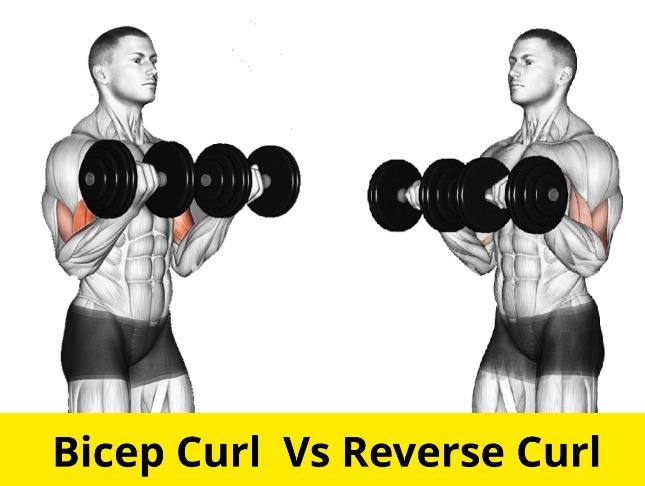
Are Hammer Curls or Bicep Curls Better?
Both hammer and bicep curls are effective exercises for building muscle in the biceps. However, they target different muscles and have other benefits.
- Hammer curls target the biceps brachii and brachialis muscles. They’re a good option for people looking to build balanced arm size.
- Bicep curls target the biceps brachii muscle more specifically. They are a good choice for people who want to make their biceps bigger.

Reverse Curls Vs Hammer Curls: Which Exercise Is Better?
Hammer curls are better than reverse curls if you want to build bigger and stronger biceps. But if you want to work on your forearms, reverse curls are better than hammer curls.
Here’s a quick summary of the battle between hammer curls and reverse curls:
- Hammer curls are a great exercise for strengthening your biceps and brachialis muscles.
- Reverse curls are a more effective for engaging the brachioradialis and other forearm muscles.
- Hammer curls are more suitable for building bicep strength and mass.
- Reverse curls are a good option for people who want to improve their grip strength and forearm development.
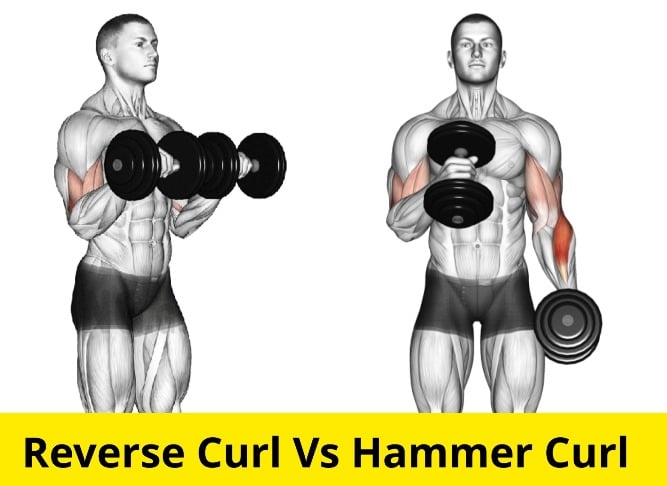
FAQs
Hammer Curl vs. Reverse Curl: When Should You Do Each?
If you are doing both exercises in the same workout, I recommend doing the hammer curl first. The hammer curl is a compound exercise that can handle heavier weights. Following with reverse curls will allow you to target the entire biceps and forearm muscles.
Should I do hammer curls or bicep curls first?
Start with hammer curls if you aim to lift heavier weights, as they can handle the load. Follow up with bicep curls for a well-rounded bicep workout. The sequence matters – it’s about maximizing muscle engagement for better gains.
Are reverse curls easier than regular curls?
Reverse curls are often considered slightly more challenging than regular curls due to their emphasis on forearm muscles. Regular curls primarily focus on the biceps, which can make them comparatively easier for some individuals.
Do reverse curls build forearms?
Yes, reverse curls are good for building forearm strength and muscle development because they work the forearm muscles, especially the brachioradialis.
Conclusion
Each curl variety has its own strengths, offering various options for creating your dream arms.
The Standard Bicep Curl is a timeless favorite. It increases biceps growth and provides a solid foundation for beginners. Despite its simplicity, it is a staple of many bicep workouts.
Hammer Curl brings a versatile approach to the arena. It’s a good choice for people who want a well-rounded arm look and strength.
Then comes the Reverse Curl, a powerhouse for forearm domination. This tool helps people improve their grip strength and focus on their forearms. It’s important for anyone who wants to strengthen their forearms.
References
- Marcolin G, Panizzolo FA, Petrone N, Moro T, Grigoletto D, Piccolo D, Paoli A. Differences in electromyographic activity of biceps brachii and brachioradialis while performing three variants of curl. PeerJ. 2018 Jul 13;6:e5165. doi: 10.7717/peerj.5165. PMID: 30013836; PMCID: PMC6047503.
- Oliveira et al. (2009) Oliveira LF, Matta TT, Alves DS, Garcia MAC, Vieira TMM. Effect of the shoulder position on the biceps brachii EMG in different dumbbell curls. Journal of Sports Science and Medicine. 2009;8(1):24–29.
- Kostek, Mark T.; Knortz, Karen Kinesiology Corner, National Strength Coaches Association Journal: December 1980 – Volume 2 – Issue 6 – p 55-55
- Krings, B. M., Shepherd, B. D., Swain, J. C., Turner, A. J., Chander, H., Waldman, H. S., … Smith, J. W. (2019). Impact of Fat Grip Attachments on Muscular Strength and Neuromuscular Activation During Resistance Exercise. Journal of Strength and Conditioning Research, 1. doi:10.1519/jsc.0000000000002954
- Kostek, Mark T.; Knortz, Karen. Kinesiology Corner: The Bicep Curl and the Reverse Bicep Curl. National Strength Coaches Association Journal: December 1980 – Volume 2 – Issue 6 – p 55-55

Manish brings over 10 years of hands-on experience in weight lifting and fat loss to fitness coaching. He specializes in gym-based training and has a lot of knowledge about exercise, lifting technique, biomechanics, and more.
Through “Fit Life Regime,” he generously shares the insights he’s gained over a decade in the field. His goal is to equip others with the knowledge to start their own fitness journey.
